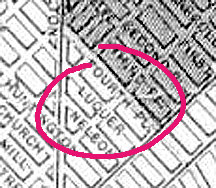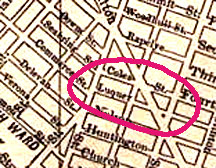YOU NEVER KNOW where you’re going to find inspiration for Forgotten NY pages. One of the interviewees in Gothamist in September 2004 was columnist/novelist Amy Sohn, and she slipped in this remark:
The F [is my favorite subway line]. It was the first train I spent a lot of time on when I moved into my very first post-grad apartment, on Clinton and Luquer. (Luquer used to be called Luqueer but someone homophobic had the signs changed.)

I had never seen Luquer Street spelled any other way than how the DOT spells it these days. Luquer is a short, 4-block street in Carroll Gardens where it begins to melt into Red Hook in Brooklyn. Luquer used to run 5 blocks, but the block between Hicks and Henry was eliminated by the construction of the Brooklyn-Queens Expressway in the early 1950s.
Luquer, despite its spelling, has always been pronounced “lu-QUEER” with the emphasis on the final syllable, and a long “e” as if there were two there. (That was borne out by my conversations with Luquer Street residents when I did the photography for this page). So, what gives? Why the strange pronunciation? Perhaps a look back in the old maps and street guides might help.

This 1866 Johnson’s Map adds the extra ‘e’, which makes sense given the pronunciation. This is the oldest map I was able to consult.

The Brooklyn Eagle, in 1891, was definitely in the one ‘e’ camp.

In 1891, Rand McNally agreed with the Eagle.

It was two ‘e’s for Wehman’s Guide in 1916.
From 1938, in both its maps and guides, Geographia stuck with Luqueer, and was consistent with it into the 1970s.
In 1942, Rand McNally was sticking with one ‘e’. (They have Dennet Place with 2 T’s, but that street name has also been in spelling flux over the years.)
In 2000, Hagstrom was pushing ‘Luquer’ to match the DOT street signs.
Actually the proper spelling is LUQUEER.
From the Brooklyn Daily Eagle, July 19, 1896:
Nearly all of the Twelfth ward, except the Jacob BERGEN estate, belonged to the VAN DYKES and LUQUEER families. The older LUQUEER, Abraham, died in 1823, and his son, Nicholas, in 1864. The BERGEN estate, by the way, took up a good portion of the Twelfth ward and half of the Tenth ward, between Gowanus bay and Clinton street and Butler and Hoyt Streets. Mr. BERGEN, who died in 1847, sold one large piece to Jordan COLES, the balance of his estate being spilt up among heirs.
Actually, Luquer Street, despite its short length, has a varied and interesting urban topography. In the above photo we are looking toward its intersection with tiny Dennet Place and in the distance, its run under the elevated IND trestle serving the F and G lines, swathed in protective canvas as it crumbles.
At right is St. Mary Star of the Sea Church, at Court and Luquer, designed in 1870 by Patrick Keely. Other NYC parishes use a latin translation, Stella Maris.
Between Court and Clinton, Luquer Street is a pleasant tree lined brownstone bastion.
A little original bluestone pavement just west of Clinton Street.
The spelling controversy isn’t quite over. I found this stenciled sign on the southwest corner at Clinton, in which the street names are hastily written over in white. If you look closely…there’s an ‘e’ chiseled in after the ‘r’; looks like this sign had “Luquere.” Now, you got me there…
So what’s the story, Jerry? Well, the mapmakers have never quite agreed. The locals have it right: the pronunciation fits the old spelling, not the new. Though Amy believes homophobia is to blame for the one ‘e’ spelling, I think it was changed because of “queer”‘s old meaning: negatively unusual, or strange.
Your webmaster did photography and scanning for this page September 12, 2004 and completed it September 13, 2004
